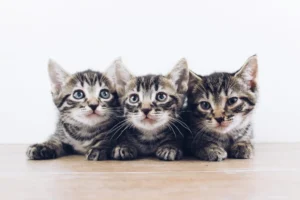Cats and dogs are beloved pets around the world, each with their own unique characteristics that make them special. One such feature that both of these animals share is their tails. Have you ever wondered why cats and dogs have tails? Let’s explore the reasons behind this common trait.
Cats and dogs have tails for a variety of reasons, including balance, communication, and even temperature regulation. Let’s delve into why these furry friends have tails and how they use them in their daily lives.
Balance
Cats and dogs rely heavily on their tails for balance, especially in situations where they need to navigate tricky terrain or make quick movements. A cat’s tail acts like a counterbalance, helping them adjust their weight and maintain stability as they leap from high places or walk along narrow ledges. Similarly, a dog’s tail assists them in shifting their body weight efficiently, whether they’re running at high speeds or making sharp turns. Without their tails, these animals would struggle to maneuver effectively and could potentially lose their footing. So, next time you see your furry friend balance effortlessly on a narrow surface, appreciate the important role their tail plays in keeping them steady!
Communication
Besides aiding in balance, cats and dogs use their tails as a crucial means of communication. A wagging tail doesn’t always imply happiness; it’s essential to consider the context and the rest of your pet’s body language to understand their emotions accurately. For instance, a cat with an upright, softly twitching tail may be feeling content or curious, while a dog with a tucked tail might be signaling fear or anxiety. By observing your pet’s tail movements along with their overall demeanor, you can better interpret their intentions and respond accordingly. Remember, your pet’s tail is like a silent language that speaks volumes to those who pay attention.
- Tip: When interacting with cats and dogs, pay close attention to the position and movement of their tails to decipher their emotions accurately. Understanding tail language can deepen your bond with your furry companion and enhance communication between you.
Remember, your pet’s tail is not just a cute appendage—it serves vital functions in helping them maintain balance and communicate with you and other animals. So, the next time you see your cat twitching its tail or your dog wagging it eagerly, appreciate the rich dialogue happening right before your eyes!
Temperature Regulation
Cats and dogs have tails for more than just looking cute – these furry appendages play an essential role in helping our beloved pets regulate their body temperature. In hot weather, dogs will often wag their tails vigorously to increase airflow, helping them cool down. Conversely, in the cold, a dog’s tail can act as a cozy little blanket, wrapping around their body to retain warmth. Similarly, cats use their tails to maintain a comfortable body temperature. When a cat is feeling too warm, you may notice them holding their tail higher to release excess heat, while a lower tail position can indicate they are trying to conserve warmth. So next time you see your pet wagging or curling their tail, know that they are just trying to keep their cool – or stay warm!
Hunting and Play
Cats and dogs are skilled hunters, and their tails play a crucial role in both hunting and playtime. Cats are known for their stealthy nature, and their tails act as a useful tool in communicating during the hunt. A twitching tail often signals excitement or focus, while a puffed-up tail can indicate fear or aggression. On the other hand, dogs use their tails as a tool for balance during high-speed chases, enhancing their agility and coordination. In playful situations, cats and dogs use their tails to communicate with each other and even with their human companions. A dog’s wagging tail or a cat’s playful flick can signal their readiness to pounce or their excitement for a game of chase. So, next time you engage in playtime with your furry friend, pay attention to their tails – they may be giving you important clues about their next move!
Additional Insight:
– A cat’s tail is also crucial for maintaining balance, especially when they jump or walk on narrow surfaces. The tail acts as a counterbalance, allowing cats to make precise and calculated movements.
Remember, our pets’ tails serve more than just a decorative purpose – they are invaluable tools that help them navigate the world around them with ease and grace.
Grooming
Cats have an innate grooming routine that involves using their tails to reach difficult spots on their bodies. Tail mobility assists them in maintaining their cleanliness by reaching areas that their tongues can’t easily access, ensuring their fur stays pristine and shiny. This self-grooming ritual is crucial for cats to regulate their body temperature and keep parasites at bay.
Unique Features
Cats and dogs come in all shapes and sizes, and their tails are no different. Some breeds have distinctive tail lengths, ranging from long and bushy to short and stubby, while others have unique tail shapes like corkscrews or tufts. These variations not only add to their charm but also serve specific functions based on their breed or species.
Additional Insight: Cats use their tails for balance and communication. A cat’s tail can act as a counterbalance when climbing or jumping, aiding their agility and precision in movement. Furthermore, tail position and movements can convey their mood or intentions to other animals and even humans.
- Maine Coons: Known for their long and flowing tails.
- Manx: Have a distinguishing feature of a short or no tail at all.
- Corgis: Famous for their docked tails, historically used for cattle herding purposes.
Remember, a cat or dog’s tail isn’t just a fluffy accessory; it’s a functional and unique part of their anatomy that serves various purposes in their daily lives.
Fun Facts
Did you know that cats use their tails for balance and communication? A cat’s tail acts as a counterbalance when they are jumping or walking on narrow surfaces, helping them stay steady and coordinated. Additionally, a cat’s tail can display their emotions – if their tail is puffed up, they may be scared or agitated, and if it’s twitching, they might be irritated.
Tail-less Breeds
Manx Cats
The Manx cat is famous for its lack of a tail or having just a small stub. This unique feature is a result of a genetic mutation that causes a shortened spine, affecting the tail. Manx cats are known for their playful and affectionate nature, making them popular pets for families.
Bobtail Dogs
Certain dog breeds, such as the Pembroke Welsh Corgi and the Australian Shepherd, are naturally born with shorter tails or even no tail at all. This genetic variation can be attributed to selective breeding by humans over time. These dogs may have a bobbed tail due to a gene mutation or surgical intervention.
Key Insight: Tail-less breeds often exhibit characteristics that compensate for the lack of a tail. For example, Manx cats are known for their strong hind legs, which provide them with extra jumping power and agility to make up for their tailless state.
Tail Wagging
Have you ever wondered why dogs wag their tails? Well, it’s not just for show! Tail wagging in dogs serves as a form of communication, allowing them to express their emotions and mood. When a dog wags its tail rapidly, it can indicate excitement or happiness, while a slower wag may signal caution or uncertainty. As pet owners, we can learn to interpret this tail language to better understand our furry friends and their needs. So, next time your dog wags its tail, pay attention to the speed and direction—it might just be trying to tell you something important.
Tail Injuries
When it comes to our pets’ tails, we want to make sure they stay healthy and injury-free. Common tail injuries in cats and dogs include fractures, dislocations, or lacerations caused by accidents or trauma. To prevent these issues, it’s essential to create a safe environment for your pets, free of hazards that could harm their tails. Additionally, regular grooming can help you spot any signs of injury or discomfort early on. If your pet does sustain a tail injury, it’s crucial to seek veterinary care promptly to prevent any further complications.
How to prevent tail injuries:
- Keep your pet’s environment free of sharp objects or dangerous obstacles.
- Avoid pulling or tugging on your pet’s tail, as this can lead to injury.
- Monitor your pet’s behavior for signs of discomfort or pain that may indicate a tail injury.
- Regularly inspect your pet’s tail for any cuts, bruises, or swelling.
Remember, our pets rely on us to keep them safe and healthy, so staying vigilant and proactive when it comes to their tail care is key.
The Role of Evolution
Throughout their evolutionary history, cats and dogs have developed tails that serve various important functions based on their specific needs and environments.
For cats, their tails play a crucial role in helping them maintain balance while navigating tricky terrains or chasing after prey. This is especially evident in larger wild cat species like lions and tigers, where the long, muscular tails act as a counterbalance during high-speed chases or sudden movements.
On the other hand, dogs’ tails have evolved to communicate various emotions and intentions to other dogs and humans. A wagging tail usually indicates excitement or happiness, while a tucked tail often signals fear or submission. Different breeds of dogs have tails of varying lengths and shapes, each serving a unique purpose in their communication with others.
Overall, the evolution of cats’ and dogs’ tails highlights how these appendages have adapted to fulfill essential functions in their daily lives, whether it’s for balance, communication, or expressing emotions.
Tail Maintenance
Keeping cats and dogs‘ tails clean and healthy is an essential part of their overall grooming routine. Regular brushing helps prevent mats and tangles in cats with longer fur, reducing the risk of skin irritation or infections. For dogs, brushing their tails can also stimulate blood flow to the area, promoting healthy skin and coat.
It’s crucial to pay attention to warning signs of potential health issues related to their tails. Look out for any changes in the tail’s appearance, such as redness, swelling, or discharge, which could indicate an infection or injury. Additionally, excessive licking or biting of the tail may signal discomfort or pain that requires veterinary attention.
By incorporating proper tail maintenance into your cat or dog‘s grooming routine, you can ensure their tails remain healthy and functional, supporting their overall well-being and quality of life.
- Grooming tip: Use a metal comb for cats with thick fur to prevent mats and tangles.
- Health alert: If you notice any unusual swelling or discharge around your dog‘s tail, consult your vet promptly to rule out any underlying health issues.
For more information on cat and dog tail health, consult a trusted resource like the American Kennel Club’s guide on tail care in pets.
Alex, a passionate animal lover, has experience in training and understanding animal behavior. As a proud pet parent to two dogs and three cats, he founded AnimalReport.net to share insights from animal experts and expand his knowledge of the animal kingdom.









